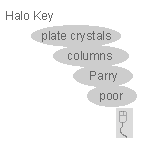South
Pole 11th January 1999.
Fisheye view pointing away from the sun by Marko
Riikonen .
This is usually a halo sparse region but here it is full of arcs, any one
of which appearing singly in temperate climes would be a cause for celebration.
Mouse over the "Halo key" to identify them.
Plate
crystals generate two bright 120º parhelia.
Singly oriented columns produce the cross
centered on the anthelic point. Two arcs, the Diffuse
and Tricker, make up the cross.
The upper Tricker arc is a loop and the whole arc is shaped like the Ancient
Egyptian "ankh" hieroglyph.
A subhelic arc touches the top of the
Tricker loop ~ a sign that their ray paths are closely related.
Wegener arcs converge at the anthelic point. There isn't an anthelion
halo as such, it only appears bright because so many arcs overlap there.
Parry oriented columns also contribute
to the Tricker and subhelic arcs. The antisolar
and heliac arcs are sharp and bright in
this view and the Hastings arc (see below) is more easily discerned
from the prominent Wegener arc.
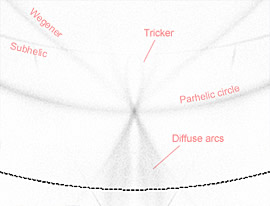 |
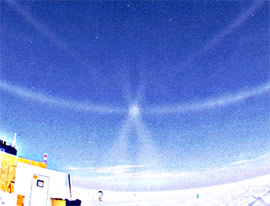 |
Anthelic region arcs
HaloSim simulation and image after levels adjustment followed by unsharp
masking.
The parhelic circle, Wegener, Tricker and diffuse arcs all cross the
anthelic point.
|
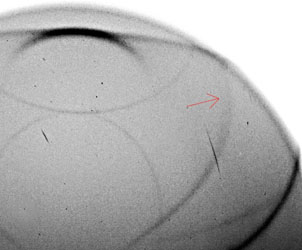 |
Hastings arc
Image converted to a b/w negative version, contrast enhanced and unsharp
masked. The elusive Hastings arc (red arrowed) curves away leftwards
from the brighter Wegener arc. The Hastings arc is generated by the
same ray paths as the Wegener arc but from Parry oriented crystals rather
than singly oriented columns. Zenith
centered view
The rare heliac, antisolar (subanthelic) and subhelic arcs are stunningly
prominent.
Specks and streaks are glints from individual low level ice crystals.
|
| |
Diffuse arcs
One of the contorted ray paths which form diffuse arcs. A ray enters a
side face of a singly oriented column. It internally reflects off three
other side faces and then an end face before emerging through the entrance
face. Run Halosim to find other paths. |
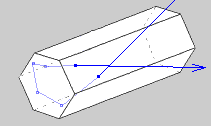 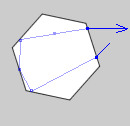 |
|
|
|
|
| |
|
Tricker arc
Produced by singly oriented columns. Tricker arc rays are like those of
the subhelic arc except that the ray path is essentially doubled by reflection
from an end face. As seen from the end of the prism the rays, like those
of the subhelic arc, are deviated through a constant 120º.
|
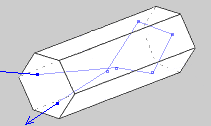 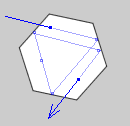 |







